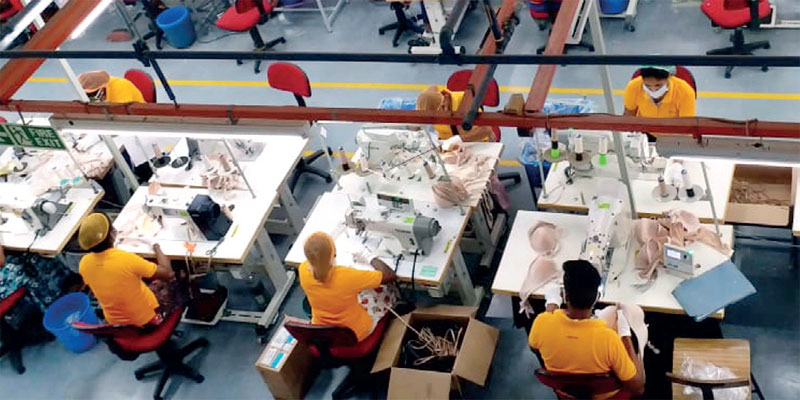Sunday Apr 20, 2025
Sunday Apr 20, 2025
Friday, 17 December 2021 03:42 - - {{hitsCtrl.values.hits}}

Apparel factory garments workers manufacturing industry
|
SLAEA Chairman and Hirdaramani Group Director Aroon Hirdaramani
|
Sri Lanka’s apparel industry expressed confidence in reaching its target of $ 8 billion in export earnings by 2025, by implementing the concerted initiatives put in place by the sector, in collaboration with the authorities.
These views were expressed at the ‘Sri Lanka Economic Summit 2021’, the flagship event of the Ceylon Chamber of Commerce, held this year on 6-7 December, under the theme ‘Springboard for revival: Opportunity to reset’.
Strengthening backward vertical integration and further improving sustainability credentials are vital in achieving the sector’s vision, while enhanced access to key export markets – including within the Asian region – will provide a significant boost in realising these aspirations, noted the industry.
“At present Sri Lanka accounts for around 1% of the global market share of apparel exports. We are confident that we can reach the industry’s target of $ 8 billion in export earnings by 2025, by executing the correct strategies,” Sri Lanka Apparel Exporters’ Association (SLAEA) Chairman and Hirdaramani Group Director Aroon Hirdaramani said.
He made these comments as a panellist at the ‘Resetting the Export Portfolio’ session of the summit.
Hirdaramani noted that the efforts to strengthen backward vertical integration of Sri Lanka’s apparel value chain, through initiatives such as the Eravur Fabric Processing Park are critical, particularly in the current context. This would pave the way for the industry to reduce lead times and significantly increase its domestic value addition – which currently stands at around 55%.
The latter would also enable Sri Lanka to make greater use of preferential tariff concessions – such as the Generalised Scheme of Preferences (GSP) Plus tariff concessions to the European Union (EU) – a critical market for Sri Lanka in general, and apparel in specific.
“We are working very hard to attract key players in the fabric segment to invest in the new zone, as well as more broadly in fabric mills in Sri Lanka,” Hirdaramani revealed, noting that the zone is expected to be positioned strongly in terms of environmental sustainability.
However, in order to attract such Foreign Direct Investment (FDI) inflows, Sri Lanka needs to strengthen especially its fiscal position and policy, other panellists indicated. This was particularly stressed by Harvard’s Centre for International Development Growth Lab Director Prof. Ricardo Hausmann, who made the initial presentation at the session.
“We can gain market share through trade shifts arising from the US-China fallout,” Hirdaramani said further. “The pandemic has also strongly increased the preference for near-shoring among buyers, given how COVID-19 caused vast disruptions to global supply chains. Sri Lanka can position as a hub to serve Asia, but this requires preferential and free trade agreements with more countries in the region.”
The need for greater trade connectivity was also noted by the other panellists. Dilmah Tea CEO Dilhan Fernando highlighted the need for FTAs and a more favourable impression of the country internationally, in order for Sri Lanka to expand and diversify its exports. Spa Ceylon Co-Founder Shalin Balasuriya too expressed the need for trade linkages, while also drawing attention to the need for trade facilitation, including reducing red-tape associated with the export process.
While securing new FTAs, the panellists – both representatives from the private sector and Sri Lanka’s foreign missions – also voiced the need to retain the existing trade concessions, particularly the GSP+ to the EU.
The panellists, particularly Export Development Board (EDB) Chairman Suresh De Mel, also emphasised the importance of supporting SMEs in order to increase and diversify exports. In the apparel sector, under the leadership of the Joint Apparel Association Forum (JAAF), initiatives are underway to boost SMEs in the industry.
Discover Kapruka, the leading online shopping platform in Sri Lanka, where you can conveniently send Gifts and Flowers to your loved ones for any event including Valentine ’s Day. Explore a wide range of popular Shopping Categories on Kapruka, including Toys, Groceries, Electronics, Birthday Cakes, Fruits, Chocolates, Flower Bouquets, Clothing, Watches, Lingerie, Gift Sets and Jewellery. Also if you’re interested in selling with Kapruka, Partner Central by Kapruka is the best solution to start with. Moreover, through Kapruka Global Shop, you can also enjoy the convenience of purchasing products from renowned platforms like Amazon and eBay and have them delivered to Sri Lanka.
Discover Kapruka, the leading online shopping platform in Sri Lanka, where you can conveniently send Gifts and Flowers to your loved ones for any event including Valentine ’s Day. Explore a wide range of popular Shopping Categories on Kapruka, including Toys, Groceries, Electronics, Birthday Cakes, Fruits, Chocolates, Flower Bouquets, Clothing, Watches, Lingerie, Gift Sets and Jewellery. Also if you’re interested in selling with Kapruka, Partner Central by Kapruka is the best solution to start with. Moreover, through Kapruka Global Shop, you can also enjoy the convenience of purchasing products from renowned platforms like Amazon and eBay and have them delivered to Sri Lanka.